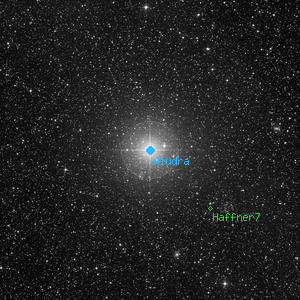Aludra

Overlaid DSS image of Aludra, 60' x 60' with north at top and west to the right
Aladin viewer for the region around Aludra
Eta Canis Majoris, η CMa, 31 CMa
CD-29 4328, HD 58350, HR 2827, WDS J07241-2918, SAO 173651, GSC 06550-04525, HIP 35904
CD-29 4328, HD 58350, HR 2827, WDS J07241-2918, SAO 173651, GSC 06550-04525, HIP 35904
| Type | Star |
|---|---|
| Magnitude | 2.45 | Right Ascension | 7h 24' 5.8" (2000) |
| Declination | 29° 18' 11" S |
| Constellation | Canis Major |
| Classification | B5Ia |
Observing Notes
Andrew Cooper
Feb 25, 2020 Waikoloa, HI (map)
20cm f/6 Newtonian, Cave Astrola @ 61x
Seeing: 7 Transparency: 7 Moon: 0%
Brilliant white, a 7th magnitude star 2' west not related otherwise no companion noted, rich galactic star field
Captain William Henry Smyth
Oct 27, 1833 No. 6 The Crescent, Bedford, England (map)
150mm f/17.6 refractor by Tully 1827
A star with a distant companion, at the root of the Greater Dog's tail; where an imaginary line from the three small stars forming Orion's head, passed through Sirius, will strike it at 17° beyond. A3, pale red; B 7½, dull grey; two small stars following. A is called Aludra, from the Arabian al-'adhrá, which is the singular of al-'adhára: see ε Canis Majoris. B proved to be No. 103 of Piazzi's Hora VII., whose reduced places give 286° for the angle of position, on a distance of 174", for the year 1800.
According to the Megale Syntaxis, Hipparchus found that the solstitial colure passed through the caudine star of the Greater Dog, which appears to have occasionally served, by its arrival at the meridian, to indicate the zero for reckoning the hours; its RA, which was then exactly 90°, rendering it convenient for that purpose. If the longitude assigned by Hipparchus to this star be compared with its present place, the annual precession will be 50".7; and both the theory of gravitation and the deductions of modern operations coincide in indicating 50".1, as the mean annual value. This will very nearly agree with the Platonic year, or complete revolution of the equinoxes in 25,920 years, as given by Ricciolus and approved by Flamsteed, at the rate of a degree in about seventy-two years. Well may Hipparchus be dubbed the Præses of ancient astronomers! See α Leonis.― A Cycle of Celestial Objects Vol II, The Bedford Catalogue, William Henry Smyth, 1844
Other Data Sources for Aludra
Nearby objects for Aludra
9 objects found within 120'
| Haffner7 | HD 56618 | HD 58215 |
| HD 59256 | HD 59890 | MCG -05-18-002 |
| NGC 2382 | Ru22 | Ruprecht 20 |
Credits...
Drawings, descriptions, and CCD photos are copyright Andrew Cooper unless otherwise noted, no usage without permission.
A complete list of credits and sources can be found on the about page
Aludra